GMC YUKON XL DENALI 2007 Manual Online
Manufacturer: GMC, Model Year: 2007, Model line: YUKON XL DENALI, Model: GMC YUKON XL DENALI 2007Pages: 608, PDF Size: 2.92 MB
Page 81 of 608
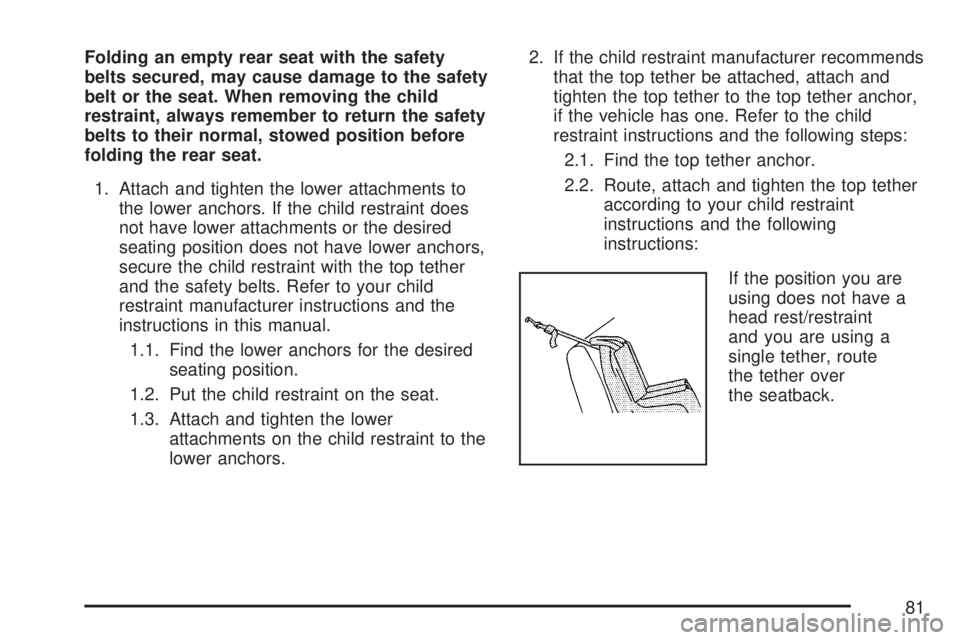
Folding an empty rear seat with the safety
belts secured, may cause damage to the safety
belt or the seat. When removing the child
restraint, always remember to return the safety
belts to their normal, stowed position before
folding the rear seat.
1. Attach and tighten the lower attachments to
the lower anchors. If the child restraint does
not have lower attachments or the desired
seating position does not have lower anchors,
secure the child restraint with the top tether
and the safety belts. Refer to your child
restraint manufacturer instructions and the
instructions in this manual.
1.1. Find the lower anchors for the desired
seating position.
1.2. Put the child restraint on the seat.
1.3. Attach and tighten the lower
attachments on the child restraint to the
lower anchors.2. If the child restraint manufacturer recommends
that the top tether be attached, attach and
tighten the top tether to the top tether anchor,
if the vehicle has one. Refer to the child
restraint instructions and the following steps:
2.1. Find the top tether anchor.
2.2. Route, attach and tighten the top tether
according to your child restraint
instructions and the following
instructions:
If the position you are
using does not have a
head rest/restraint
and you are using a
single tether, route
the tether over
the seatback.
81
Page 82 of 608
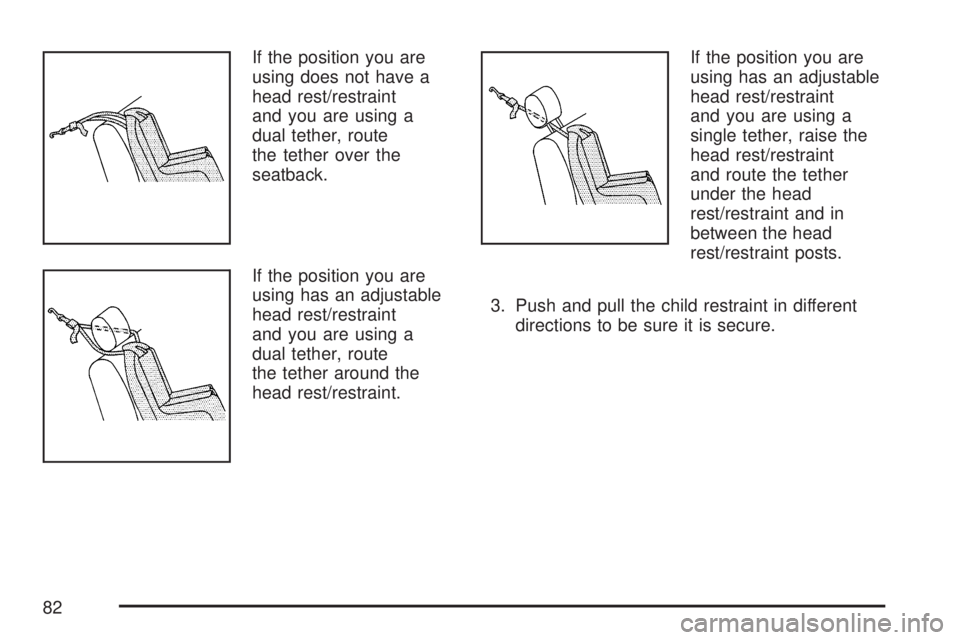
If the position you are
using does not have a
head rest/restraint
and you are using a
dual tether, route
the tether over the
seatback.
If the position you are
using has an adjustable
head rest/restraint
and you are using a
dual tether, route
the tether around the
head rest/restraint.If the position you are
using has an adjustable
head rest/restraint
and you are using a
single tether, raise the
head rest/restraint
and route the tether
under the head
rest/restraint and in
between the head
rest/restraint posts.
3. Push and pull the child restraint in different
directions to be sure it is secure.
82
Page 83 of 608
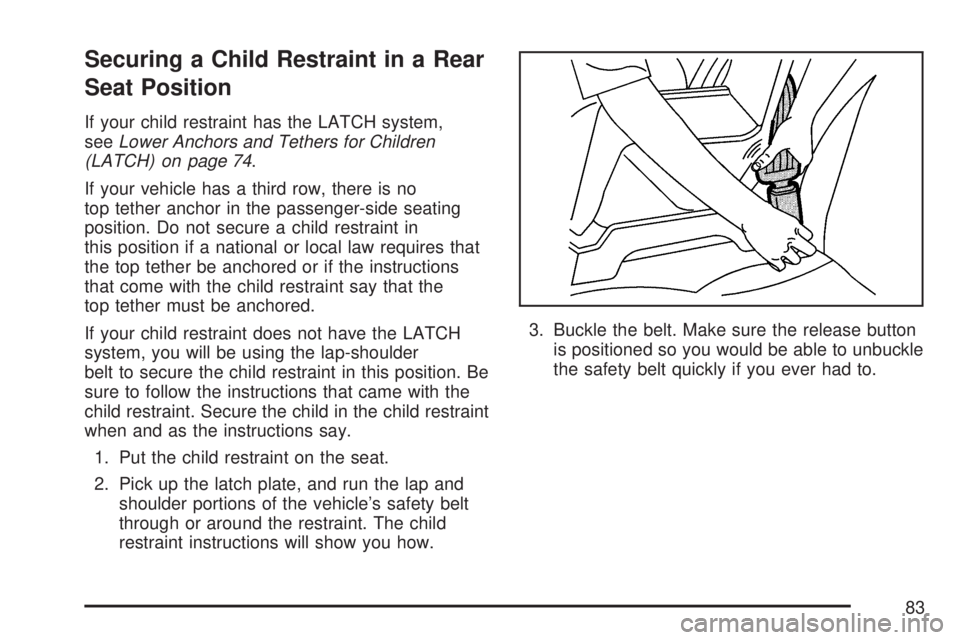
Securing a Child Restraint in a Rear
Seat Position
If your child restraint has the LATCH system,
seeLower Anchors and Tethers for Children
(LATCH) on page 74.
If your vehicle has a third row, there is no
top tether anchor in the passenger-side seating
position. Do not secure a child restraint in
this position if a national or local law requires that
the top tether be anchored or if the instructions
that come with the child restraint say that the
top tether must be anchored.
If your child restraint does not have the LATCH
system, you will be using the lap-shoulder
belt to secure the child restraint in this position. Be
sure to follow the instructions that came with the
child restraint. Secure the child in the child restraint
when and as the instructions say.
1. Put the child restraint on the seat.
2. Pick up the latch plate, and run the lap and
shoulder portions of the vehicle’s safety belt
through or around the restraint. The child
restraint instructions will show you how.3. Buckle the belt. Make sure the release button
is positioned so you would be able to unbuckle
the safety belt quickly if you ever had to.
83
Page 84 of 608
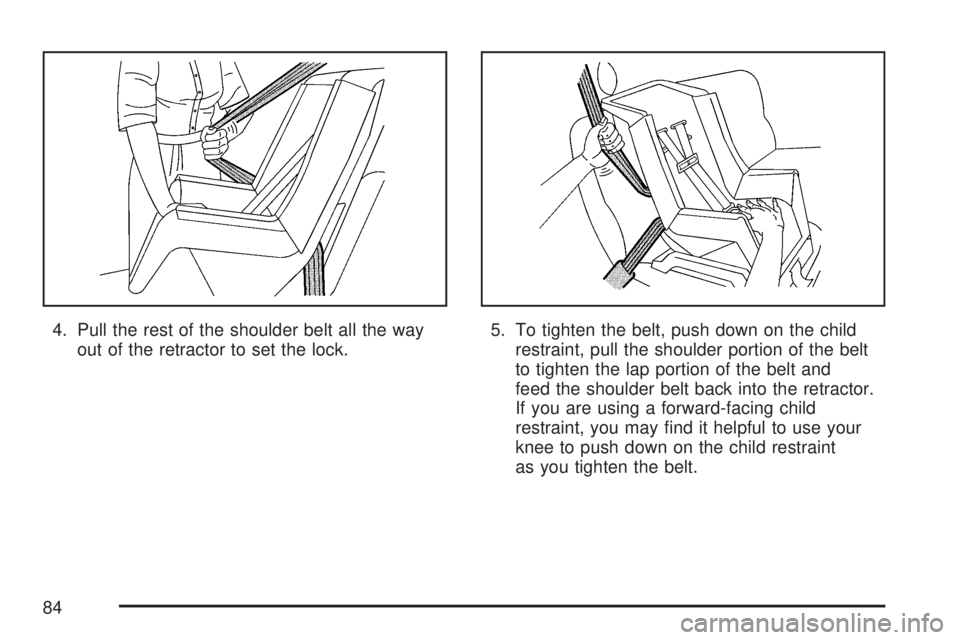
4. Pull the rest of the shoulder belt all the way
out of the retractor to set the lock.5. To tighten the belt, push down on the child
restraint, pull the shoulder portion of the belt
to tighten the lap portion of the belt and
feed the shoulder belt back into the retractor.
If you are using a forward-facing child
restraint, you may �nd it helpful to use your
knee to push down on the child restraint
as you tighten the belt.
84
Page 85 of 608
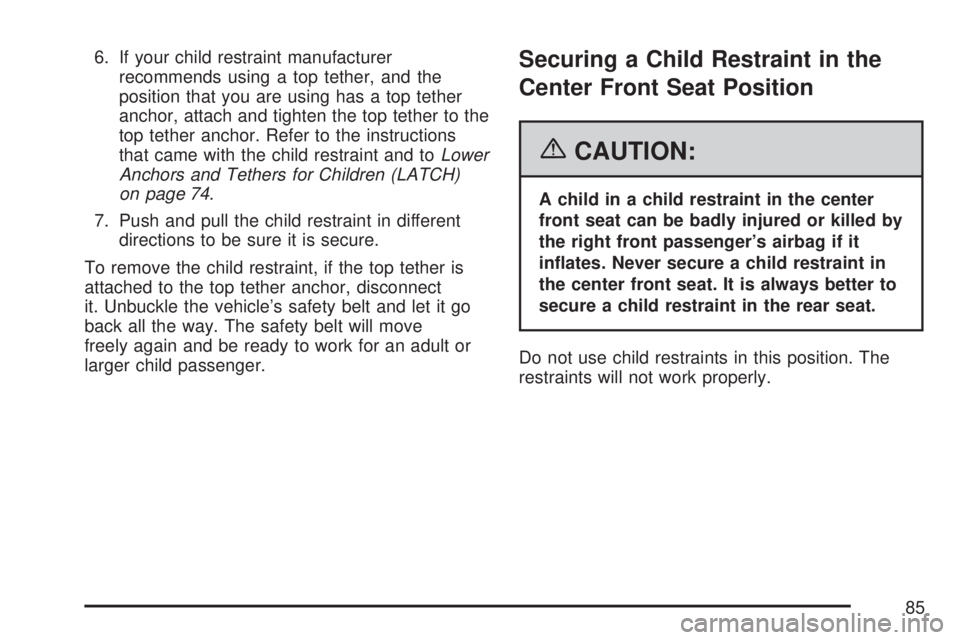
6. If your child restraint manufacturer
recommends using a top tether, and the
position that you are using has a top tether
anchor, attach and tighten the top tether to the
top tether anchor. Refer to the instructions
that came with the child restraint and toLower
Anchors and Tethers for Children (LATCH)
on page 74.
7. Push and pull the child restraint in different
directions to be sure it is secure.
To remove the child restraint, if the top tether is
attached to the top tether anchor, disconnect
it. Unbuckle the vehicle’s safety belt and let it go
back all the way. The safety belt will move
freely again and be ready to work for an adult or
larger child passenger.Securing a Child Restraint in the
Center Front Seat Position
{CAUTION:
A child in a child restraint in the center
front seat can be badly injured or killed by
the right front passenger’s airbag if it
in�ates. Never secure a child restraint in
the center front seat. It is always better to
secure a child restraint in the rear seat.
Do not use child restraints in this position. The
restraints will not work properly.
85
Page 86 of 608
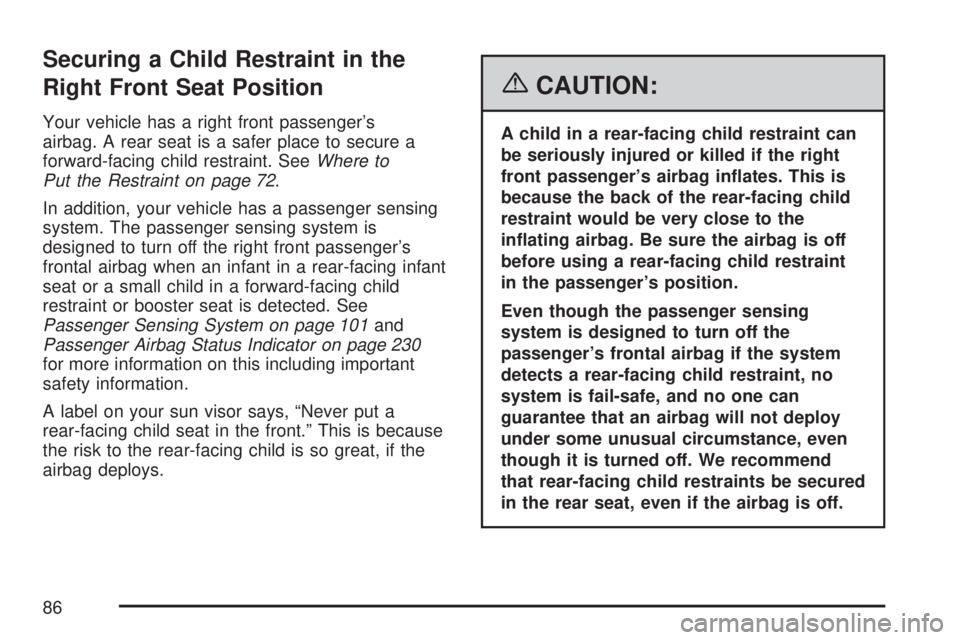
Securing a Child Restraint in the
Right Front Seat Position
Your vehicle has a right front passenger’s
airbag. A rear seat is a safer place to secure a
forward-facing child restraint. SeeWhere to
Put the Restraint on page 72.
In addition, your vehicle has a passenger sensing
system. The passenger sensing system is
designed to turn off the right front passenger’s
frontal airbag when an infant in a rear-facing infant
seat or a small child in a forward-facing child
restraint or booster seat is detected. See
Passenger Sensing System on page 101and
Passenger Airbag Status Indicator on page 230
for more information on this including important
safety information.
A label on your sun visor says, “Never put a
rear-facing child seat in the front.” This is because
the risk to the rear-facing child is so great, if the
airbag deploys.
{CAUTION:
A child in a rear-facing child restraint can
be seriously injured or killed if the right
front passenger’s airbag in�ates. This is
because the back of the rear-facing child
restraint would be very close to the
in�ating airbag. Be sure the airbag is off
before using a rear-facing child restraint
in the passenger’s position.
Even though the passenger sensing
system is designed to turn off the
passenger’s frontal airbag if the system
detects a rear-facing child restraint, no
system is fail-safe, and no one can
guarantee that an airbag will not deploy
under some unusual circumstance, even
though it is turned off. We recommend
that rear-facing child restraints be secured
in the rear seat, even if the airbag is off.
86
Page 87 of 608
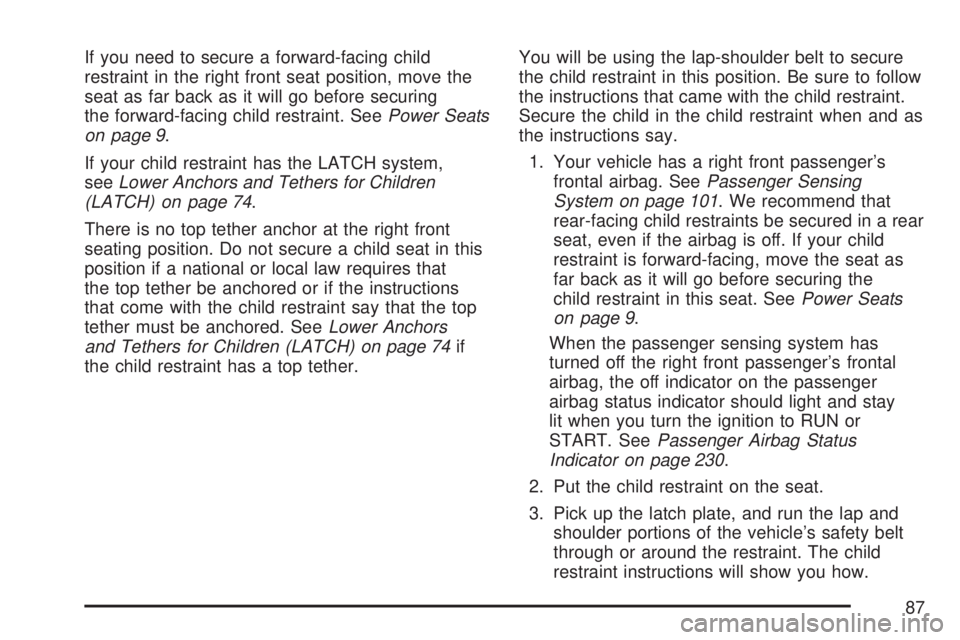
If you need to secure a forward-facing child
restraint in the right front seat position, move the
seat as far back as it will go before securing
the forward-facing child restraint. SeePower Seats
on page 9.
If your child restraint has the LATCH system,
seeLower Anchors and Tethers for Children
(LATCH) on page 74.
There is no top tether anchor at the right front
seating position. Do not secure a child seat in this
position if a national or local law requires that
the top tether be anchored or if the instructions
that come with the child restraint say that the top
tether must be anchored. SeeLower Anchors
and Tethers for Children (LATCH) on page 74if
the child restraint has a top tether.You will be using the lap-shoulder belt to secure
the child restraint in this position. Be sure to follow
the instructions that came with the child restraint.
Secure the child in the child restraint when and as
the instructions say.
1. Your vehicle has a right front passenger’s
frontal airbag. SeePassenger Sensing
System on page 101. We recommend that
rear-facing child restraints be secured in a rear
seat, even if the airbag is off. If your child
restraint is forward-facing, move the seat as
far back as it will go before securing the
child restraint in this seat. SeePower Seats
on page 9.
When the passenger sensing system has
turned off the right front passenger’s frontal
airbag, the off indicator on the passenger
airbag status indicator should light and stay
lit when you turn the ignition to RUN or
START. SeePassenger Airbag Status
Indicator on page 230.
2. Put the child restraint on the seat.
3. Pick up the latch plate, and run the lap and
shoulder portions of the vehicle’s safety belt
through or around the restraint. The child
restraint instructions will show you how.
87
Page 88 of 608
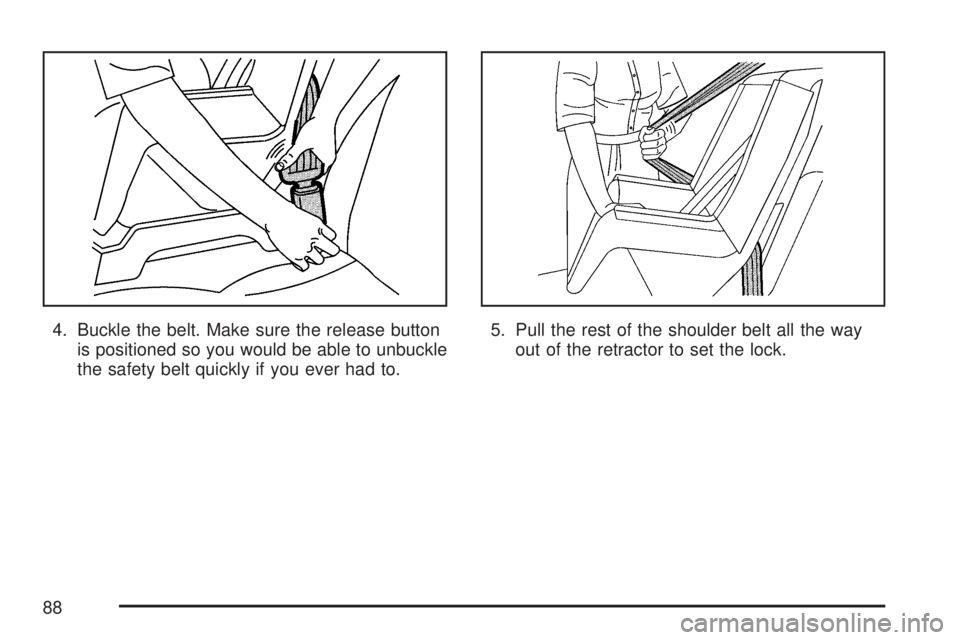
4. Buckle the belt. Make sure the release button
is positioned so you would be able to unbuckle
the safety belt quickly if you ever had to.5. Pull the rest of the shoulder belt all the way
out of the retractor to set the lock.
88
Page 89 of 608
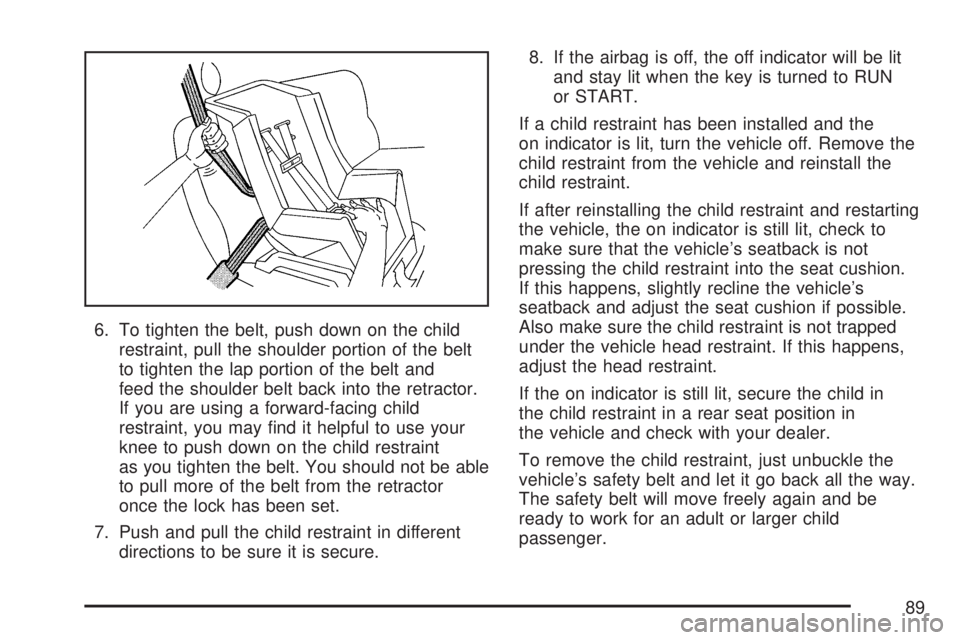
6. To tighten the belt, push down on the child
restraint, pull the shoulder portion of the belt
to tighten the lap portion of the belt and
feed the shoulder belt back into the retractor.
If you are using a forward-facing child
restraint, you may �nd it helpful to use your
knee to push down on the child restraint
as you tighten the belt. You should not be able
to pull more of the belt from the retractor
once the lock has been set.
7. Push and pull the child restraint in different
directions to be sure it is secure.8. If the airbag is off, the off indicator will be lit
and stay lit when the key is turned to RUN
or START.
If a child restraint has been installed and the
on indicator is lit, turn the vehicle off. Remove the
child restraint from the vehicle and reinstall the
child restraint.
If after reinstalling the child restraint and restarting
the vehicle, the on indicator is still lit, check to
make sure that the vehicle’s seatback is not
pressing the child restraint into the seat cushion.
If this happens, slightly recline the vehicle’s
seatback and adjust the seat cushion if possible.
Also make sure the child restraint is not trapped
under the vehicle head restraint. If this happens,
adjust the head restraint.
If the on indicator is still lit, secure the child in
the child restraint in a rear seat position in
the vehicle and check with your dealer.
To remove the child restraint, just unbuckle the
vehicle’s safety belt and let it go back all the way.
The safety belt will move freely again and be
ready to work for an adult or larger child
passenger.
89
Page 90 of 608
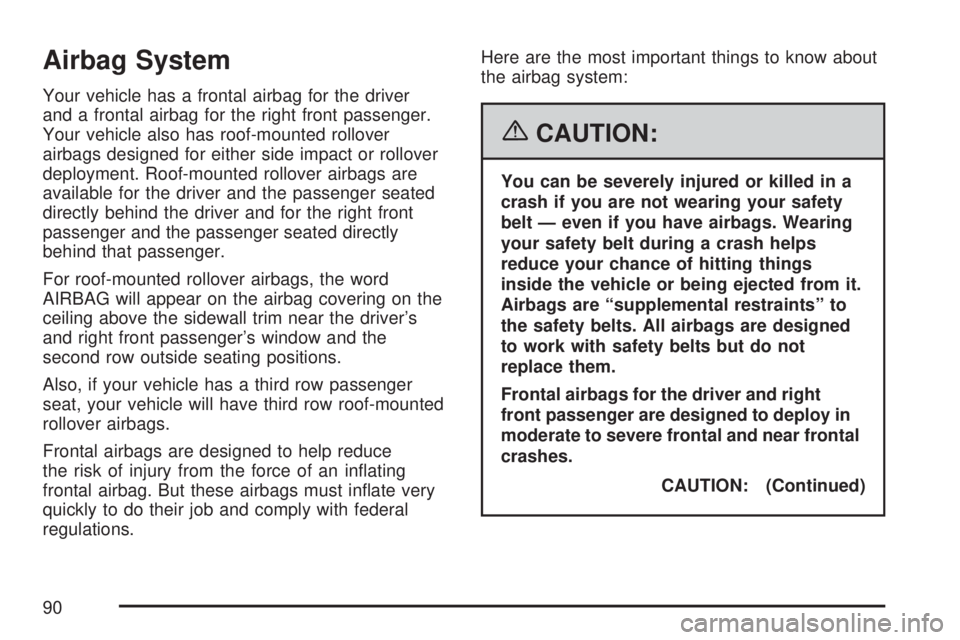
Airbag System
Your vehicle has a frontal airbag for the driver
and a frontal airbag for the right front passenger.
Your vehicle also has roof-mounted rollover
airbags designed for either side impact or rollover
deployment. Roof-mounted rollover airbags are
available for the driver and the passenger seated
directly behind the driver and for the right front
passenger and the passenger seated directly
behind that passenger.
For roof-mounted rollover airbags, the word
AIRBAG will appear on the airbag covering on the
ceiling above the sidewall trim near the driver’s
and right front passenger’s window and the
second row outside seating positions.
Also, if your vehicle has a third row passenger
seat, your vehicle will have third row roof-mounted
rollover airbags.
Frontal airbags are designed to help reduce
the risk of injury from the force of an in�ating
frontal airbag. But these airbags must in�ate very
quickly to do their job and comply with federal
regulations.Here are the most important things to know about
the airbag system:
{CAUTION:
You can be severely injured or killed in a
crash if you are not wearing your safety
belt — even if you have airbags. Wearing
your safety belt during a crash helps
reduce your chance of hitting things
inside the vehicle or being ejected from it.
Airbags are “supplemental restraints” to
the safety belts. All airbags are designed
to work with safety belts but do not
replace them.
Frontal airbags for the driver and right
front passenger are designed to deploy in
moderate to severe frontal and near frontal
crashes.
CAUTION: (Continued)
90